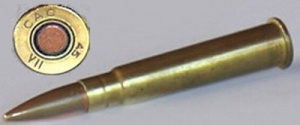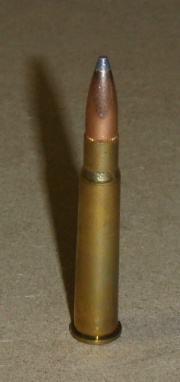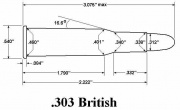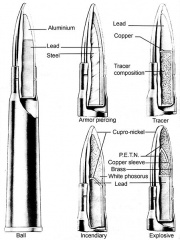.303 British
| .303 British (7.7x56mm Rimmed) | ||||||||||||||||
|---|---|---|---|---|---|---|---|---|---|---|---|---|---|---|---|---|

| ||||||||||||||||
| .303 Cartridge (Mk 7) | ||||||||||||||||
| Type | Rifle | |||||||||||||||
| Country of Origin | United Kingdom | |||||||||||||||
| Specifications | ||||||||||||||||
| Case Type | Rimmed, bottleneck | |||||||||||||||
| Bullet Ø | 0.311 in (7.9 mm) | |||||||||||||||
| Neck Ø | 0.338 in (8.6 mm) | |||||||||||||||
| Shoulder Ø | 0.401 in (10.2 mm) | |||||||||||||||
| Base Ø | 0.460 in (11.7 mm) | |||||||||||||||
| Rim Ø | 0.540 in (13.7 mm) | |||||||||||||||
| Rim Thickness | .064 in (1.6 mm) | |||||||||||||||
| Case Length | 2.222 in (56.4 mm) | |||||||||||||||
| Full Length | 3.075 in (78.1 mm) | |||||||||||||||
| Rifling twist | 1-10 inches | |||||||||||||||
| Primer | Large rifle | |||||||||||||||
| Production & Service | ||||||||||||||||
| Design Date | 1880s | |||||||||||||||
| Production Dates | 1880s-present | |||||||||||||||
| Variants | see below | |||||||||||||||
| In Service | 1889-1950s UK | |||||||||||||||
| Used By | United Kingdom, Commonwealth, others | |||||||||||||||
| Wars | too many to list | |||||||||||||||
| Ballistic Performance Sampling | ||||||||||||||||
| ||||||||||||||||
.303 British is the commercial name of the .311 inch calibre rifle and machine gun cartridge first developed in Britain in the 1880s as a blackpowder round, later adapted to use cordite and then smokeless powder propellant. It was the standard British and Commonwealth military cartridge from 1889 until the 1950s, when it was replaced by the 7.62x51mm NATO round, and in the 1980s by the 5.56x45mm NATO in most roles. It is popular due to the large number of surplus military rifles chambered for the round which have been released to the civilian market, some of which have subsequently been modified for sporting use.
The difference between the .303 (7.7 mm) name and the .311 inch (7.9 mm) bullet size is due to the cartridge being named after the size of the bore measured between the lands which is .303, following the older blackpowder practice, rather than being named for the overall size of the bore, which is .311, nominal, although bores for many .303 surplus military rifles often can be found ranging from around .309 inch up to .318 inch. For surplus military rifles with bores of .313 or larger, achieving accuracy with other than handloaded .303 rounds using slightly oversize bullets is often difficult.
This cartridge saw much sporting use with surplus military rifles, especially in Australia and Canada, and to a lesser extent, in the United States. In Canada, it was found to be adequate for any game except the great bears. In Australia, it was common for old military rifles to be re-barreled in .303/25 and .303/22.
Contents |
Mark I Solid Case
The Cartridge, S.A., Ball, Magazine Rifle, Mark I Solid Case, .303inch was first introduced with the Lee-Metford rifle in 1889. In its original form, the round was a 215-grain (13.9 g) round-nosed cupro-nickel jacketed bullet propelled by 71.5 grains (4.63 g) of RFG2 Blackpowder, giving it a muzzle velocity of 1,830 ft/s (560 m/s) and a chamber pressure of about 38,000 PSI (260 MPa). Blackpowder is not very dense, and the charge had to be pressed into a solid pellet in order to fit inside the round. The rimmed cartridge made it easy to extract spent rounds from the chamber, although it did make them somewhat harder to stack in a magazine because the protruding rims would cause a jam if they were loaded incorrectly due to a double feed—that is the rim of the cartridge being fed by the bolt snagging the subsequent cartridge rim.
Mark 1, 2 Cordite
Cordite was used as a propellant from 1891 and the first adopted cordite cartridge, the Cartridge S.A. Ball, Magazine Rifle Cordite Mark 1, used the same bullet but delivered 1,970 ft/s (600 m/s) at a chamber pressure of about 35,000 PSI (240 MPa). Small changes to the bullet jacket resulted in the Mark II of both the black powder and cordite versions, the Mark 2 and Mark 2.C respectively.
Nitrocellulose was first used as a propellant in 1894, but the higher temperatures and chemical activity was enough to make it unsuitable for use in the Lee-Metford, and the newer Lee-Enfield was introduced to address these problems. Although not officially adopted until 1916, nitrocellulose rounds were widely used during World War I, although cordite-loaded rounds were still produced for use in the tropics, where it was considered to be more stable.
Marks 3, 4, 5, 6
The round-nosed bullet was found to be unsatisfactory when used in combat, particularly when compared to the dum-dum rounds issued in limited numbers in 1897 during the Chitral and Tirah expeditions of 1897/98 on the North West Frontier of India. This led to the introduction of the Cartridge S.A. Ball .303 inch Cordite Mark 3, basically the original 215-grain (13.9 g) bullet with the jacketing cut back to expose the lead in the nose. Similar hollow-point bullets were used in the Mark 4 and 5 rounds, the primary production versions. These highly effective soft-nosed and hollow-point bullets were later prohibited by the St Petersburg Declaration and in 1903 they were withdrawn from active service and were afterwards to be used for target practice until stocks ran out. To replace them the Mark 6 round was introduced in 1904, using a round nose bullet similar to the Mark 2 but with a thinner jacket. It was generally agreed to be unsatisfactory.
Mark 7
In 1905 Mauser changed bullet design completely with the introduction of their spitzer rounds, the first of the classic design now referred to universally as "bullet shaped". In addition to being pointed, the round was also much lighter in order to deliver a higher muzzle velocity. It was found that as velocity increased the bullets suddenly became much more deadly.
In 1910, the British took the opportunity to replace their Mark 6 rounds with a more modern design. The Mark 7 (Mark VII) used a 174-grain (11.3 g) pointed bullet with a flat-base which gave a muzzle velocity of 2,440 ft/s (740 m/s).[2] The Mark 7 was different from earlier .303 bullet designs or spitzer projectiles in general. Although the Mark 7 round looks like a conventional full metal jacket bullet, this appearance is deceptive: its designers deliberately made the front third of the interior of the Mark 7 bullet out of aluminium or wood pulp, instead of lead. This shifted the centre of gravity of the bullet towards the rear, making it tail heavy. Although the bullet was stable in flight due to the gyroscopic forces imposed on it by the rifling of the barrel, it behaved very differently upon hitting the target. As soon as the bullet hit the target and decelerated, its heavier lead base caused it to yaw violently and deform, thereby inflicting more severe gunshot wounds than a standard spitzer design.[3] In spite of this, the bullet was legal according to the terms of the Hague Convention.
The Mark 7 (and later Mark 8) rounds have versions utilizing nitrocellulose propellants. The nitrocellulose versions - first introduced in World War I - were designated with a "Z" postfix indicated after the type (e.g. Mark VIIZ, with a weight of 175 grains) and in headstamps.
Perhaps the most famous single .303 British round ever fired was on April 21 1918, during the Great War, when Manfred von Richthofen, the famed "Red Baron" flying ace, was mortally wounded by a single .303 Mk 7 round.[4] The shot was most likely fired from the ground, though there were three possible contenders: a Vickers machine gun on the ground, a pursuing fighter with a machine gun, and riflemen on the ground.
Mark 8
In 1938 the Mark 8 (Mark VIII) round was approved to obtain greater range from the Vickers machine gun. Slightly heavier than Mk 7 ammunition at 175 grains (11.3 g), the primary difference was the addition of a boat-tail and more propellant, giving a muzzle velocity of 2,550 ft/s (780 m/s). As a result, the chamber pressure was significantly higher, at 40,000–42,000 lbf/sq in (approximately 280 MPa) compared to the 39,000 lbf/sq in of the Mark VII round. Cross-sectional images of Mk VIII ammunition indicate that its boat-tail was long and tapered gently, providing a very high ballistic coefficient. Mk VIII ammunition was described as being for "All suitably sighted .303-inch small arms and machine guns" but caused significant bore erosion in weapons previously using cordite due to the channelling effect of the boat tail. As a result it was prohibited from general use with rifles and light machine guns, except in an emergency where no other ammunition was available.
Tracer, Armour-piercing and Incendiary
Tracer and armour-piercing cartridges were introduced during 1915. Explosive bullets of the Pomeroy design as Mark VII.Y in 1916.
Several incendiaries were privately developed from 1914 to counter the Zeppelin threat, but none were approved until the Brock design late in 1916 as BIK Mark VII.K Wing Cmdr. Brock RNVR was a member of the Brock fireworks-making family.
These rounds were extensively developed over the years and saw several Mark numbers. The last tracer round introduced into British service was the G Mark 8 in 1945, the last armour-piercing round was the W Mark 1Z in 1945, and the last incendiary round was the B Mark 7 in 1942. Explosive bullets were not produced in the UK after 1933 due to the relatively small amount of explosive that could be contained in the bullet limiting their effectiveness, their role being successfully fulfilled by the use of Mark 6 and 7 incendiary bullets.
In 1935 the .303 O Mark 1 Observing round was introduced for use in machine guns. The bullet to this round was designed to break up with a puff of smoke on impact. The later Mark 6 and 7 incendiary rounds could also be used in this role if required.
During World War I British factories alone produced 7,000,000,000 rounds of .303 ammunition. Factories in other countries added greatly to this total.
Japanese 7.7 mm ammunition
Japan produced a number of machine guns that were direct copies of Lewis and Vickers machine guns (Type 92 machine gun and Type 97 machine gun respectively), these were primarily used in Navy aircraft. The ammunition used is of the same specification as .303 British.
- Ball 174 grains (11.3 g). CuNi jacket with a composite aluminium/lead core. Black primer.
- A.P. brass jacket with a steel core. White primer.
- Tracer 130 grains (8.4 g). CuNi jacket with a lead core. Red primer.
- Incendiary 133 grains (8.6 g). Brass jacket with white phosphorus and lead core. Green primer.
- H.E. a Copper jacket with a PETN and lead core. Purple primer.
Note: standard Japanese ball ammunition was very similar to the British Mk 7 cartridge. Both had identical bullet weights and a "tail-heavy" design, as can be seen in the cut-away diagram.
Military Surplus Ammunition
Military surplus .303 British ammunition is often available, notably at gun shows. It may or may not have corrosive primers. Care must be taken to identify the round properly before purchase or loading into weapons. Cartridges with the Roman numeral VIII on the headstamp are the Mark 8 round, specifically designed for use in Vickers machine guns. Although Mark 8 ammunition works well in a Vickers gun, it should not be used in rifles because the boat-tailed design causes increased barrel wear. The boat-tailed bullet design of Mk 8 ammunition is not in itself a problem. However, when combined with the cordite propellant used in Mk 8 cartridges, which burns at a much higher temperature than nitrocellulose, there is increased barrel erosion. The cumulative effects of firing Mk 8 ammunition through rifles were known of during the Second World War, and British riflemen were ordered to avoid using it, except in emergencies. The best general-purpose ammunition for any .303 military rifle is the Mark 7 design because it provides the best combination of accuracy and stopping power.
Civilian Ammunition


Finding a reliable source of civilian ammunition for weapons chambered in .303 British does not pose problems. Modern ammunition is still manufactured by major producers such as Remington, Federal, Winchester, Sellier & Bellot and Wolf etc. Reloading equipment and ammunition components are also manufactured by companies such as Hornady. Where extreme accuracy is required, the Sierra Matchking 174-grain (11.3 g) HPBT bullet is a popular choice. Commercially produced ammunition is widely available in various FMJ, soft point, hollow point, flat-based and boat tail designs - both spitzer and round-nosed. The classic 174-grain (11.3 g) FMJ bullets are widely available, though purchasers may wish to check whether or not these feature the tail-heavy Mk 7 design. In any case other bullet weights are available e.g. 150, 180 and 200-grain (13 g), both for hunting and target purposes.
Weapons chambered for .303 British
- Bren light machine gun
- Browning Model 1919 machine gun aircraft version
- Canadian Ross Rifle Mk I through III
- Charlton Automatic Rifle
- Charlton machine gun
- Lee-Enfield rifle
- Lee-Metford rifle
- Lewis gun
- Martini-Enfield rifle
- P14 rifle
- Vickers machine gun
- Vickers K machine gun
- Winchester Model 1895
- Parker-Hale Sporter Rifle
- Huot automatic rifle
- Hotchkiss .303 Mk I & I*
See also
- British military rifles
- Caliber conversion sleeve
- List of rifle cartridges
- .303 Savage
- .30-06 Springfield
- .308 Winchester
- 7 mm caliber Other cartridges of similar size
References
- ↑ .303 British Accurate Powder
- ↑ History of the .303 British Calibre Service Ammunition Round David Cushman
- ↑ The Deadly .303 British and The Box O' Truth Box of Truth website
- ↑ "The Death of Manfred von Richthofen: Who fired the fatal shot?" by Dr M. Geoffrey Miller
External links
- Photos of the contents of different .303 British cartridges Box of Truth website
- Photo of Sellier & Bellot 150 gr (9.7 g) .303 British soft-point fired into ballistic gelatin (bullet travelled right to left)
- Photos of .303 bullet penetrating a hardened steel target
- Photos of various different types of .303 ammunition
- African Hunter
- .303 Sniper Central
- .303 British 303british.com
- Headstamps of various .303 ammunition producers David Cushman

